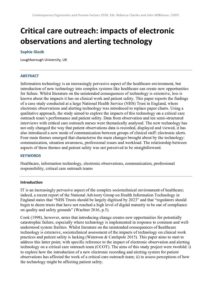| Document | Author Sophie Glazik |
| Abstract Information technology is an increasingly pervasive aspect of the healthcare environment, but introduction of new technology into complex systems like healthcare can create new opportunities for failure. Whilst literature on the unintended consequences of technology is extensive, less is known about the impacts it has on clinical work and patient safety. This paper reports the findings of a case study conducted at a large National Health Service (NHS) Trust in England, where electronic observations and alerting technology was introduced to replace paper charts. Using a qualitative approach, the study aimed to explore the impacts of this technology on a critical care outreach team’s performance and patient safety. Data from observation and ten semi-structured interviews with critical care outreach nurses were thematically analysed. The new technology has not only changed the way that patient observations data is recorded, displayed and viewed, it has also introduced a new mode of communication between groups of clinical staff: electronic alerts. Four main themes emerged that characterise the main changes brought about by the technology: communication, situation awareness, professional issues and workload. The relationship between aspects of these themes and patient safety was not perceived to be straightforward. |

